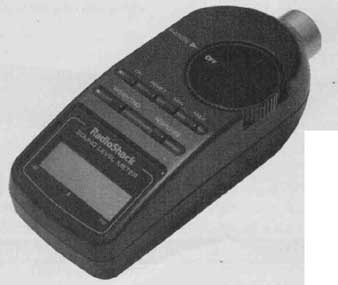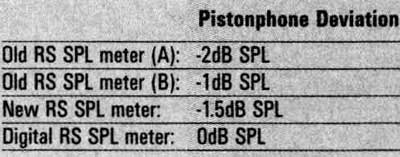|
|
Let’s investigate the characteristics of the Radio Shack Sound Level Meter in regard to its accuracy.
The Radio Shack Sound Level Meter is a versatile and economical device, used for calibrating home theater speaker levels, subwoofer level matching to main speakers, low-frequency room-mode analysis, and measuring loudspeakers. Conveniently, an output jack is provided on these sound level meters, which al lows connections to personal computer sound cards, and permits usage 0 these devices via PC-based acoustic measurement programs. But how accurate is this device and is it the appropriate tool to be used in the aforementioned activities?
 PHOTO 1: RS Sound level meter (new model).
PHOTO 1: RS Sound level meter (new model).
The Radio Shack Analog-Display Sound Level Meter (referred to here after as the RS SPL meter) has seen a model change. The new version (Photo 1, model number: 33-4050) is more compact than its predecessor. I assume that many users still own the older, now-discontinued version (Photo 2, model number: 33-2050), so I include it here. The Radio Shack Digital-Display Sound Level Meter (Photo 3, model number: 33-2055) features a digital readout of the sound level instead of a moving needle.
I had access to two of the older-model RS SPL meters, one new model, and a digital version. I used these four units for this study.
FREQUENCY RESPONSE DETERMINATION METHOD
I devised a method to determine the frequency response of the four RS SPL meters. First, I took a reference measurement using a calibrated Mitey Mike II microphone and a custom-made microphone preamplifier. From its specification sheet, the Mitey Mike II has a flat response in the low-frequency range, to 20Hz. The custom-made microphone preamplifier was designed to have a flat frequency response down to DC. I used LMS, which uses stepped sine signal acquisition to perform all acoustic measurements.

PHOTO 2: RS sound level meter (old, discontinued model).

PHOTO 3: RS digital-display sound level meter.
One speaker I used in making this reference measurement was a 6½” two- way bookshelf speaker with a relatively flat frequency response (88Hz 20k1-Iz, ±2dB). Because the bookshelf speaker’s frequency response extends down to only 88Hz (-3dB), I used a subwoofer with an approximately flat frequency response down to 16Hz (16Hz - 200Hz, ±2dB) to ascertain the low frequency region. I measured the bookshelf speaker using the ground-plane method and the pseudo-anechoic (gated) method.
I performed both measurement methods for the bookshelf speaker because when the RS SPL meter is placed flat on the ground, its microphone element edge is about 1cm off the ground. I surmised that this height differential in the ground-plane measurement may limit high-frequency accuracy Therefore, for high frequencies (above 500Hz), I used pseudo-anechoic measurements, which place the RS SPL meter microphone element clear of reflection boundaries. I measured the subwoofer using the ground-plane method.
I used each of the four RS SPL meters to measure the bookshelf speaker and subwoofer. Then I calculated the difference between the RS SPL meter measurements and the reference measurement for both the bookshelf speaker (ground-plane and pseudo-anechoic methods) and subwoofer to deter mine the RS SPL frequency responses. I spliced difference calculations for the subwoofer and bookshelf speaker (ground-plane) around 180Hz. Then, I spliced the ground-plane and pseudo anechoic bookshelf speaker difference calculations around 500Hz to complete the RS SPL meter frequency responses. Figure 1 illustrates this process as a flowchart.
RESULTS
I used a Bruel & Kjaer Type 4220 pistonphone to check the absolute dB accuracy for all four RS SPL meters, which Radio Shack claims have an ac curacy of ±2dB at 114dB SPL. The B&K pistonphone produces a calibration SPL of 124dB SPL at 250Hz. Table 1 displays the dB SPL deviation, from factory settings, referenced to the pistonphone calibration level.
All RS SPL meters used the “C weighting” setting, which has the factory-claimed frequency response of 32Hz (±3dB). Figure 2 plots the four calculated RS SPL meter frequency responses. Table 2 displays general observations regarding low-frequency cutoff (-3dB point) and mid- band tolerance (32Hz 10kHz) from analyzing the calculated RS SPL meter frequency responses.
Table 3 lists the 1/3-octave spaced low-frequency deviation compared to the Mitey Mike II and its associated electronics. Although I used only two samples of the old RS SPL meter, one of the new RS SPL meters, and one digital RS SPL meter -- in this study, those who require some compensation values for their respective versions of the RS SPL meters may wish to apply these numbers for correction when performing ½-octave low- frequency measurements.
DISCUSSION
The absolute dB SPL the RS SPL meters measured referenced to the B&K Type 4220 pistonphone were within ±1dB. These RS SPL meters are quite accurate in the actual sound pressure level they measure. This is quite impressive for an inexpensive device!
The old RS SPL meters mostly matched the low- and upper-end rolloff characteristics of the C-weighting curve (Fig. 3). However, the new RS SPL meter deviates from the C-weighting characteristic in the low-frequency roll- off. The digital RS SPL meter has a less steep low-frequency rolloff compared to the new RS SPL meter, but still a few decibels off relative to the old RS SPL meters. The digital RS SPL meter also does not show the correct C-weighting high-frequency rolloff behavior above 10kHz.
For all four RS SPL meters, the region above 550Hz deviated from a flat frequency response by as much as +18dB (!) for the digital meter, resulting in various peaks and dips. Although the old RS SPL meters mostly met the manufacturer’s claimed frequency response of 32Hz -10kHz (±3dB), the new RS SPL meter’s early low-frequency rolloff and large peaks in the high frequencies demonstrated large deviation (±7dB) from the manufacturer’s claim. The digital RS SPL meter fared even worse, with a huge peak at 6kHz that resulted in an even larger deviation (±10.4dB) from the manufacturer’s claim.

TABLE 1: Absolute sound pressure level deviation of the four RS SPL meters
referenced to a B&K Type 4220 Pistonphone. Pistonphone Deviation

TABLE 2: Low-frequency cutoff and mid-band tolerance for the four RS SPL meters.

TABLE 3: 1/3-octave spaced low-frequency rolloff of the four RS SPL meters.

FIGURE 2: Calculated RS SPI meter frequency responses, relative to calibrated
Mitey Mike II and associated electronics.
Based on the calculated response of the RS SPL meters, comments regarding the appropriateness of using this device for common usages can be qualified:
---Home-theater speaker level matching: It is perfectly fine to use the RS SPL meter for this usage, be cause you are only level matching main, center, and surround speakers, the speakers are subject to the same frequency aberrations of the RS SPL meter, and it shouldn’t make a difference whether you use the old, new, or digital model.
---Subwoofer level matching to main speakers: Matching subwoofer levels to main speakers is probably accept able for the old RS SPL meter, but perhaps questionable for the new meter and the digital meter. Because the old RS SPL meter has a low-frequency response that extends down to 24Hz (-3dB), using a test CD such as the Stereophile Test CD’s 1/3-octave warble tones to level match a subwoofer to main speakers shouldn’t pose a problem. This is especially true with the commonly used 80Hz subwoofer crossover frequency of home-theater receivers. With the old meter, you can play four 1/3-octave spaced tones below 80Hz (63, 50, 40, and 31.5Hz) with relative accuracy. Using the new or digital meter may not produce ideal results, because its low-frequency ex tension is -3dB at 41Hz and 32Hz, respectively.
---Low-frequency room-mode analysis: This is probably OK for small to medium rooms for the old RS SPL meter, but may not be suitable for the new or digital meter, because room modes may appear reduced in amplitude. Attenuation of low-frequency room mode peaks with a parametric EQ may result in under- compensation if what is measured is deficient in output.
Of the four domestic rooms in which I performed low-frequency room-mode analysis, 40Hz was the lowest room mode encountered in a particular room with the approximate dimensions of 13’ W x 13’ D x 8’ H (4m x 4m x 2.4m). Obviously, larger rooms will have lower room modes, and for these cases, none of the RS SPL meters should be used for accurate low-frequency room-mode analysis.
---Measuring loudspeakers. With the C-weighted frequency characteristic and deviating frequency response above 550Hz, it is probably not a good idea to use any of the RS SPL meters to measure loudspeakers accurately, unless the meter can be calibrated to compensate for the low- and high-frequency response deviations. Even then, I’m unsure of the implications of using a device, such as the digital RS SPL meter, for precision acoustics measurement, which requires up to ±10.4dB of amplitude correction. For example, a slightly off-axis high-frequency measurement with copious amounts of compensation may exhibit a highly erroneous result.
CONCLUSION
The absolute dB SPL measurements for all four units were surprisingly accurate. It is unfortunate that the older-model sound level meters (which were the only meters that mostly met the manufacturer’s specifications for frequency response) are no longer in production. Neither the new meter nor the digital meter seems to demonstrate fidelity similar to the older models. However, if you are aware of its frequency-response limitations, even the new or digital meter can be a highly useful and afford able acoustic tool, especially for home- theater speaker level matching and some subwoofer level matching. The old RS SPL meter should be suitable for low-frequency room mode analysis in all but the largest domestic rooms.
For the new or digital meter, you could perform low-frequency room- mode analysis in perhaps smaller rooms, although accurate loudspeaker measurements are best avoided for all meters. In any case, the new Analog-Display Radio Shack Sound Level Meter can be had for $44.99 (US) and the Digital- Display Sound Level Meter for $49.99 ( US), which are bargains considering its capabilities and features. Anyone curious about measuring sound should own one.
I would like to thank HSU Research for allowing me to use their measurement facilities. Additional thanks for Dr. Poh Ser Hsu for his insight, and Mr. Lanny Dalton for the loan of the digital sound level meter.
REFERENCES
1. S. Muller and P. Massarani, “Transfer-Function Measurement with Sweeps,” J. Audio Eng. Soc., Vol. 49, pp. 443-471 (2001 Jun.).
2. J. D’Appolito, Testing Loudspeakers.
3. LMS 4.1 User Manual (LinearX Systems Inc., Tualatin, 2000).
4. M. Gander, “Ground-Plane Acoustic Measurement of Loudspeaker Systems,” J. Audio Eng. Soc., Vol. 30, pp. 723-731 (1982 Oct.).

FIGURE 3: A, B, and C weighting response characteristics for sound level meters.
(F. Alton Everest, Master Handbook of Acoustics ( McGraw-Hill, New York, 2001),
pp. 39, Fig. 2-3].
Everything You Wanted To Know About Sound Level Meters (SLMs)
= = = =